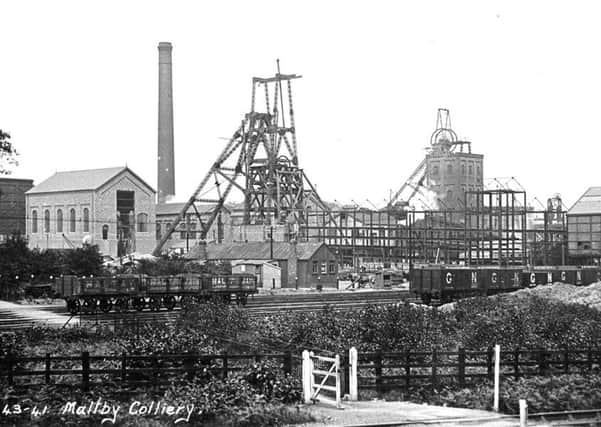Nostalgia on Tuesday: The Main story


In the following years the small rural village of Maltby was transformed into a vibrant colliery community which witnessed two terrible disasters, trouble on the picket lines in the 1984/85 Miners strike, and the colliery undergo several major redevelopments before closure in 2013. In May 1907 it was announced the Maltby Main Colliery Company had been registered with a capital of £350,000 in £1 shares. It was the company’s intention to acquire from the Sheepbridge Coal & Iron Co. Ltd and others, freehold coal and mining leases of the Barnsley seam of coal under lands in certain parishes of Yorkshire and Nottinghamshire and establish a mining business.
By September 17, 1907 the Leeds and Yorkshire Mercury, was reporting the contractors’ line of the South Yorkshire Joint Lines Railway had been laid as far as Maltby colliery. A portion of the sidings from the railway to the site of the pit had been completed, and the preparation for sinking had made good progress. Whilst collieries were being sunk in quick succession in South Yorkshire, along with the laying of many railway lines, the Sheffield Daily Telegraph of July 2, 1907 ran an article headed ‘Developing the coalfield and spoiling the beautiful’. It speculated on what social thinker and philanthropist John Ruskin’s reaction would be ‘to spoiling beauty spots in the Maltby Valley with its interesting though ruined Cistercian Abbey, the beautiful woodlands and enchanting valleys’.
Advertisement
Hide AdAdvertisement
Hide AdRuskin said some very severe things about railways and wrote in a very caustic strain about the spoiling of the countryside in the Buxton Valley. ‘You blasted its rocks away, heaped thousands of tons of shale into its lovely stream and the valley is gone...’ Sinking operations at Maltby colliery were carried out between 1908 and 1911. No 2 shaft to the Barnsley Seam was reached on June 17, 1910. The fastest rate of sinking was 18 yards a week. No 1 shaft reached the Barnsley Seam on January 21, 1911. Labour was attracted not only from the surrounding villages but from as far afield as Derbyshire, Durham, Lancashire and Ireland.
A new village was laid out in anticipation of the coming of the colliers, between the old Maltby village, and the pithead. Some 400 houses were erected on a site laid out on ‘model village’ lines, a central space being reserved for a village green or recreation ground. House building was not being tackled by the Colliery company, but a local builder.
During the early days there were between 300 and 400 men winning coal by hand and filling it into tubs. At a shareholders’ meeting in July 1911, Maurice Deacon, chairman and managing director of the Maltby Main Colliery company, reported that the erection of plant was proceeding satisfactorily.
Maltby Main colliery was the scene of a terrible explosion in the early hours of Monday morning, August 20, 1911. Three miners lost their lives and a number of men who went to their aid and rescue had narrow escapes. Another disaster occurred at Maltby pit on July 28, 1923. A gob fire (spontaneous combustion of waste behind the coalface) had been discovered in the Low East District; during sealing-off operations there was a violent explosion, and 28 men lost their lives.
Advertisement
Hide AdAdvertisement
Hide AdTwo years later the first pithead baths were built a welcome facility; newer baths were completed in 1939.
During 1926 Maltby came under Denaby &Cadeby Main Collieries Ltd and in 1935 under the Amalgamated Denaby Collieries Ltd. This was a powerful concern which also ran collieries at Denaby, Cadeby, Dinnington and Rossington.
By the mid 1930s a million tons of coal per annum was being mined with large quantities of industrial gas and coking coals, as well as the world-famous ‘London Brights’ being extracted. Major reconstruction work was carried out at the colliery from early 1957. As the pit has grew so too did the local population. In 1923 there were 7,000 inhabitants by the end of the 1950s the population had doubled.
A major project was begun at Maltby in 1981 to reach the Parkgate Seam. The work involved constructing a new mineral shaft and a new pit bottom. Early on 21 September 1984, police and pickets clashed at Maltby when six contractors, many of whom were members of the NUM, and who had not worked for the previous six and a half months, crossed the miners’ picket lines to continue work on a new shaft being constructed. The contractors were escorted into the pit by police in a convoy at 6.40 a.m. The contractors did not stop to talk to the pit gate pickets. Police said there were 6,000 pickets but reporters who were able to walk through the pickets said there were 2,000. It was reported there were around 1,000 officers in a cordon or on standby. After three horse box lorries arrived, carrying fifteen horses from South Yorkshire’s mounted branch, one picket quipped: ‘Bloody hell, are they running the Doncaster St Leger here?’
Advertisement
Hide AdAdvertisement
Hide AdAt the beginning of February 1989, Maltby miners sent records tumbling. They produced their fastest million tonnes, breaking a sixteen-year-old record. The colliery hit the jackpot on 6 February when the millionth tonne surfaced a full six weeks faster than the previous record, set in 1973.
Maltby Colliery was acquired by R. J. B. Mining in 1994 but was sold to Hargreaves Services in 2007. In 2012 the company announced Maltby Main was considered no longer viable on safety, geological and financial grounds. Closure followed early in 2013.